Statistical Analysis Report
VerifiedAdded on 2020/07/22
|15
|2563
|40
Report
AI Summary
This report presents a comprehensive statistical analysis using SPSS, covering various aspects such as levels of measurement, identification of variables, measures of central tendency, and graphical representations. It includes a detailed examination of trust in the police, utilizing descriptive and inferential statistics to analyze data trends and relationships. The report also discusses the implications of the findings and suggests areas for improvement in the police system based on public trust.

SPSS
Paraphrase This Document
Need a fresh take? Get an instant paraphrase of this document with our AI Paraphraser
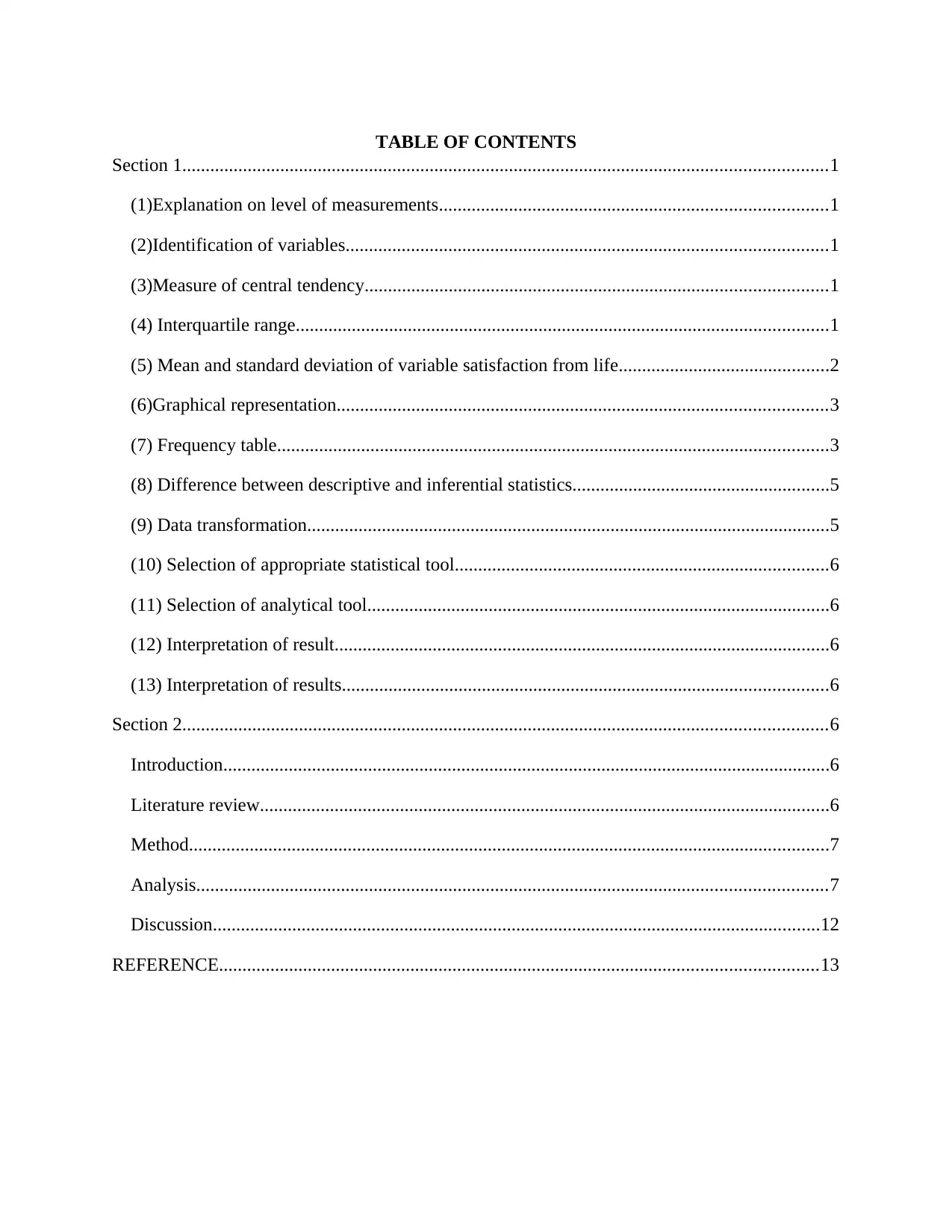
TABLE OF CONTENTS
Section 1..........................................................................................................................................1
(1)Explanation on level of measurements...................................................................................1
(2)Identification of variables.......................................................................................................1
(3)Measure of central tendency...................................................................................................1
(4) Interquartile range..................................................................................................................1
(5) Mean and standard deviation of variable satisfaction from life.............................................2
(6)Graphical representation.........................................................................................................3
(7) Frequency table......................................................................................................................3
(8) Difference between descriptive and inferential statistics.......................................................5
(9) Data transformation................................................................................................................5
(10) Selection of appropriate statistical tool................................................................................6
(11) Selection of analytical tool...................................................................................................6
(12) Interpretation of result..........................................................................................................6
(13) Interpretation of results........................................................................................................6
Section 2..........................................................................................................................................6
Introduction..................................................................................................................................6
Literature review..........................................................................................................................6
Method.........................................................................................................................................7
Analysis.......................................................................................................................................7
Discussion..................................................................................................................................12
REFERENCE................................................................................................................................13
Section 1..........................................................................................................................................1
(1)Explanation on level of measurements...................................................................................1
(2)Identification of variables.......................................................................................................1
(3)Measure of central tendency...................................................................................................1
(4) Interquartile range..................................................................................................................1
(5) Mean and standard deviation of variable satisfaction from life.............................................2
(6)Graphical representation.........................................................................................................3
(7) Frequency table......................................................................................................................3
(8) Difference between descriptive and inferential statistics.......................................................5
(9) Data transformation................................................................................................................5
(10) Selection of appropriate statistical tool................................................................................6
(11) Selection of analytical tool...................................................................................................6
(12) Interpretation of result..........................................................................................................6
(13) Interpretation of results........................................................................................................6
Section 2..........................................................................................................................................6
Introduction..................................................................................................................................6
Literature review..........................................................................................................................6
Method.........................................................................................................................................7
Analysis.......................................................................................................................................7
Discussion..................................................................................................................................12
REFERENCE................................................................................................................................13

Section 1
(1)Explanation on level of measurements Nominal: Nominal variables are those variables which are categorical in nature and
elements are not arranged in specific order (Definition of nominal variable, 2017). Ordinal: Ordinal variables are those variables where each and every category is listed in
specific order. Likert scale is commonly used for ordinary variables (Hough and et.al.,
2010). Ratio: It is the interval variable and show varied range in which values comes.
Measurment of temperature is the example of ratio scale. Binary: It is the variable which have two values which may be 1,0 or yes and no or
success and failure etc.
(2)Identification of variables Nominal: IMSMETN is one of the nominal variable where different classifications are
done like allow some, allow none and refusal. Ordinal: POLINTR is the ordinal variable where categories are listed as very interested,
quite interested, hardly interested and refusal etc. Ratio: ALCKWDY is the ratio varible in the input sheet. Binary:GNDR is the variable that comes in category of gender.
(3)Measure of central tendency
Descriptive Statistics
N Mean Std.
Deviation
Felt depressed, how
often past week 39975 1.44 .668
Legal marital status 20356 5.20 1.191
State of education in
country nowadays 38505 5.71 2.326
Valid N (listwise) 19294
(4) Interquartile range
Descriptives
1 | P a g e
(1)Explanation on level of measurements Nominal: Nominal variables are those variables which are categorical in nature and
elements are not arranged in specific order (Definition of nominal variable, 2017). Ordinal: Ordinal variables are those variables where each and every category is listed in
specific order. Likert scale is commonly used for ordinary variables (Hough and et.al.,
2010). Ratio: It is the interval variable and show varied range in which values comes.
Measurment of temperature is the example of ratio scale. Binary: It is the variable which have two values which may be 1,0 or yes and no or
success and failure etc.
(2)Identification of variables Nominal: IMSMETN is one of the nominal variable where different classifications are
done like allow some, allow none and refusal. Ordinal: POLINTR is the ordinal variable where categories are listed as very interested,
quite interested, hardly interested and refusal etc. Ratio: ALCKWDY is the ratio varible in the input sheet. Binary:GNDR is the variable that comes in category of gender.
(3)Measure of central tendency
Descriptive Statistics
N Mean Std.
Deviation
Felt depressed, how
often past week 39975 1.44 .668
Legal marital status 20356 5.20 1.191
State of education in
country nowadays 38505 5.71 2.326
Valid N (listwise) 19294
(4) Interquartile range
Descriptives
1 | P a g e
⊘ This is a preview!⊘
Do you want full access?
Subscribe today to unlock all pages.

Trusted by 1+ million students worldwide
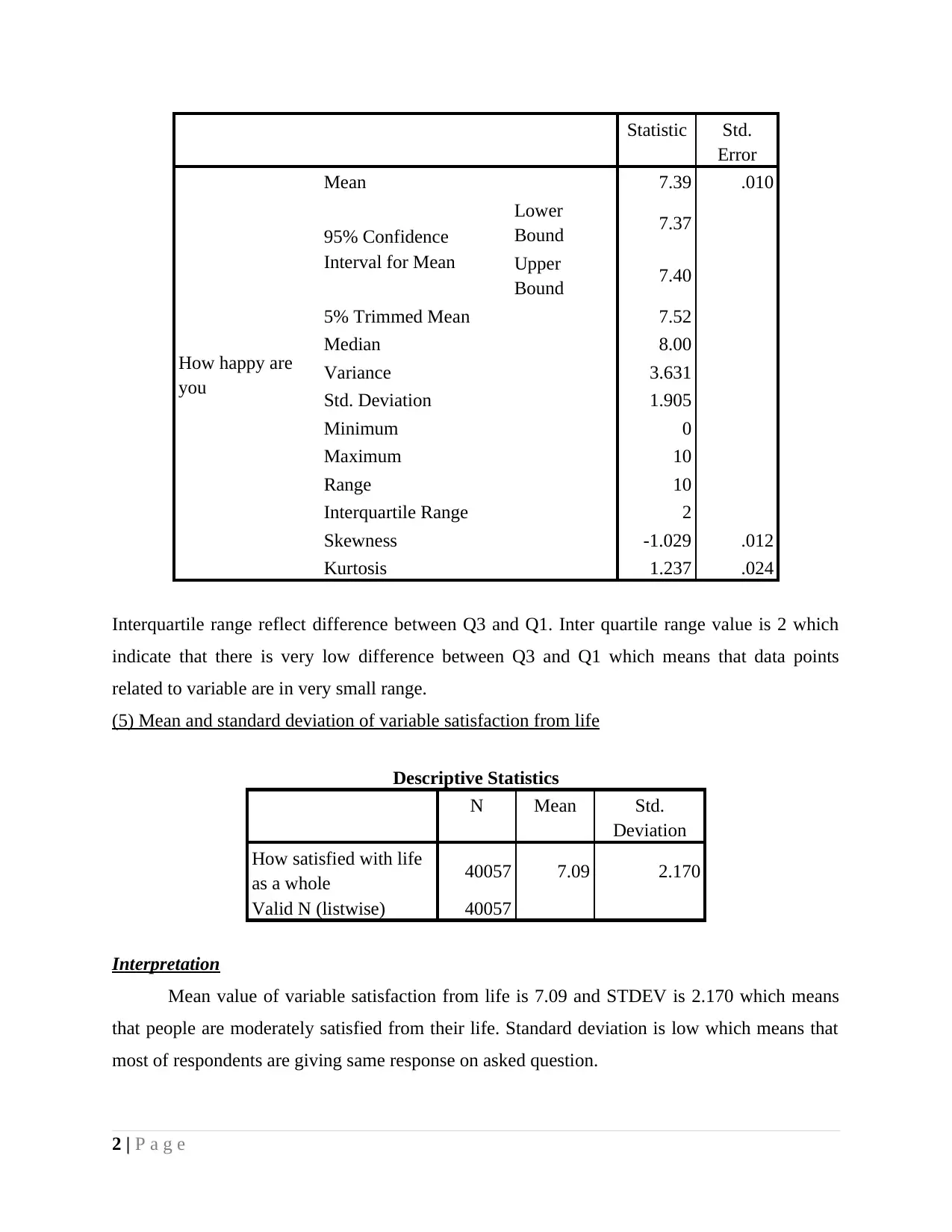
Statistic Std.
Error
How happy are
you
Mean 7.39 .010
95% Confidence
Interval for Mean
Lower
Bound 7.37
Upper
Bound 7.40
5% Trimmed Mean 7.52
Median 8.00
Variance 3.631
Std. Deviation 1.905
Minimum 0
Maximum 10
Range 10
Interquartile Range 2
Skewness -1.029 .012
Kurtosis 1.237 .024
Interquartile range reflect difference between Q3 and Q1. Inter quartile range value is 2 which
indicate that there is very low difference between Q3 and Q1 which means that data points
related to variable are in very small range.
(5) Mean and standard deviation of variable satisfaction from life
Descriptive Statistics
N Mean Std.
Deviation
How satisfied with life
as a whole 40057 7.09 2.170
Valid N (listwise) 40057
Interpretation
Mean value of variable satisfaction from life is 7.09 and STDEV is 2.170 which means
that people are moderately satisfied from their life. Standard deviation is low which means that
most of respondents are giving same response on asked question.
2 | P a g e
Error
How happy are
you
Mean 7.39 .010
95% Confidence
Interval for Mean
Lower
Bound 7.37
Upper
Bound 7.40
5% Trimmed Mean 7.52
Median 8.00
Variance 3.631
Std. Deviation 1.905
Minimum 0
Maximum 10
Range 10
Interquartile Range 2
Skewness -1.029 .012
Kurtosis 1.237 .024
Interquartile range reflect difference between Q3 and Q1. Inter quartile range value is 2 which
indicate that there is very low difference between Q3 and Q1 which means that data points
related to variable are in very small range.
(5) Mean and standard deviation of variable satisfaction from life
Descriptive Statistics
N Mean Std.
Deviation
How satisfied with life
as a whole 40057 7.09 2.170
Valid N (listwise) 40057
Interpretation
Mean value of variable satisfaction from life is 7.09 and STDEV is 2.170 which means
that people are moderately satisfied from their life. Standard deviation is low which means that
most of respondents are giving same response on asked question.
2 | P a g e
Paraphrase This Document
Need a fresh take? Get an instant paraphrase of this document with our AI Paraphraser

(6)Graphical representation
On basis of chart it can be said that majority of respondents resides in town or small city
and country village. There are moderate number of respondents that are living in big city. In
Suburbs and countryside very small number of people reside. Hence, majority of respondents are
those that live in big city, town or country village.
(7) Frequency table
Feeling of safety of walking alone in local area after dark
Frequency Percent Valid
Percent
Cumulative
Percent
Valid Very safe 11758 29.3 29.6 29.6
Safe 20288 50.5 51.0 80.6
Unsafe 6412 16.0 16.1 96.7
3 | P a g e
On basis of chart it can be said that majority of respondents resides in town or small city
and country village. There are moderate number of respondents that are living in big city. In
Suburbs and countryside very small number of people reside. Hence, majority of respondents are
those that live in big city, town or country village.
(7) Frequency table
Feeling of safety of walking alone in local area after dark
Frequency Percent Valid
Percent
Cumulative
Percent
Valid Very safe 11758 29.3 29.6 29.6
Safe 20288 50.5 51.0 80.6
Unsafe 6412 16.0 16.1 96.7
3 | P a g e
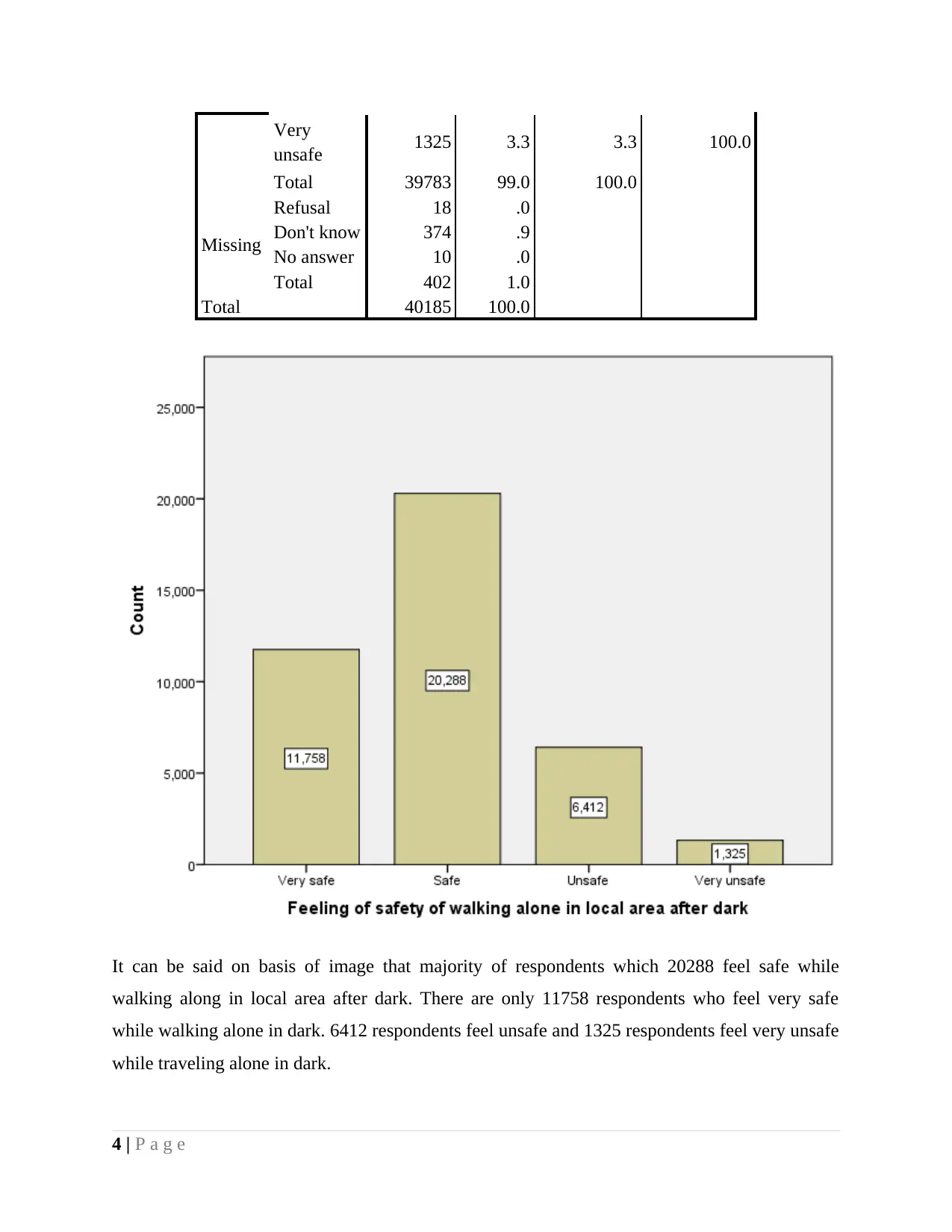
Very
unsafe 1325 3.3 3.3 100.0
Total 39783 99.0 100.0
Missing
Refusal 18 .0
Don't know 374 .9
No answer 10 .0
Total 402 1.0
Total 40185 100.0
It can be said on basis of image that majority of respondents which 20288 feel safe while
walking along in local area after dark. There are only 11758 respondents who feel very safe
while walking alone in dark. 6412 respondents feel unsafe and 1325 respondents feel very unsafe
while traveling alone in dark.
4 | P a g e
unsafe 1325 3.3 3.3 100.0
Total 39783 99.0 100.0
Missing
Refusal 18 .0
Don't know 374 .9
No answer 10 .0
Total 402 1.0
Total 40185 100.0
It can be said on basis of image that majority of respondents which 20288 feel safe while
walking along in local area after dark. There are only 11758 respondents who feel very safe
while walking alone in dark. 6412 respondents feel unsafe and 1325 respondents feel very unsafe
while traveling alone in dark.
4 | P a g e
⊘ This is a preview!⊘
Do you want full access?
Subscribe today to unlock all pages.

Trusted by 1+ million students worldwide

(8) Difference between descriptive and inferential statistics
There is difference between descriptive and inferential statistics as in first one past data is
analyzed and trends are identified mean and standard deviation (Snyder and Wenger, 2010). On
other hand, in inferential statictics predictions are made through tools like regression analysis.
(9) Data transformation
In order to do grouping in category data transformation tab is used in SPSS and under this recode
into different variable option is selected. Thereafter, recoding of values from 1to 2 is done as 1, 3
to 5 as 2, 6 to 8 as 3 and 9 to 10 as 4. Thereafter, in data input sheet in values column name is
assigned to 1,2,3, and 4 as small, medium, large and very large. In this way, entire data
transformation is done. Majority of respondents comes in small and medium category as in small
5 | P a g e
There is difference between descriptive and inferential statistics as in first one past data is
analyzed and trends are identified mean and standard deviation (Snyder and Wenger, 2010). On
other hand, in inferential statictics predictions are made through tools like regression analysis.
(9) Data transformation
In order to do grouping in category data transformation tab is used in SPSS and under this recode
into different variable option is selected. Thereafter, recoding of values from 1to 2 is done as 1, 3
to 5 as 2, 6 to 8 as 3 and 9 to 10 as 4. Thereafter, in data input sheet in values column name is
assigned to 1,2,3, and 4 as small, medium, large and very large. In this way, entire data
transformation is done. Majority of respondents comes in small and medium category as in small
5 | P a g e
Paraphrase This Document
Need a fresh take? Get an instant paraphrase of this document with our AI Paraphraser
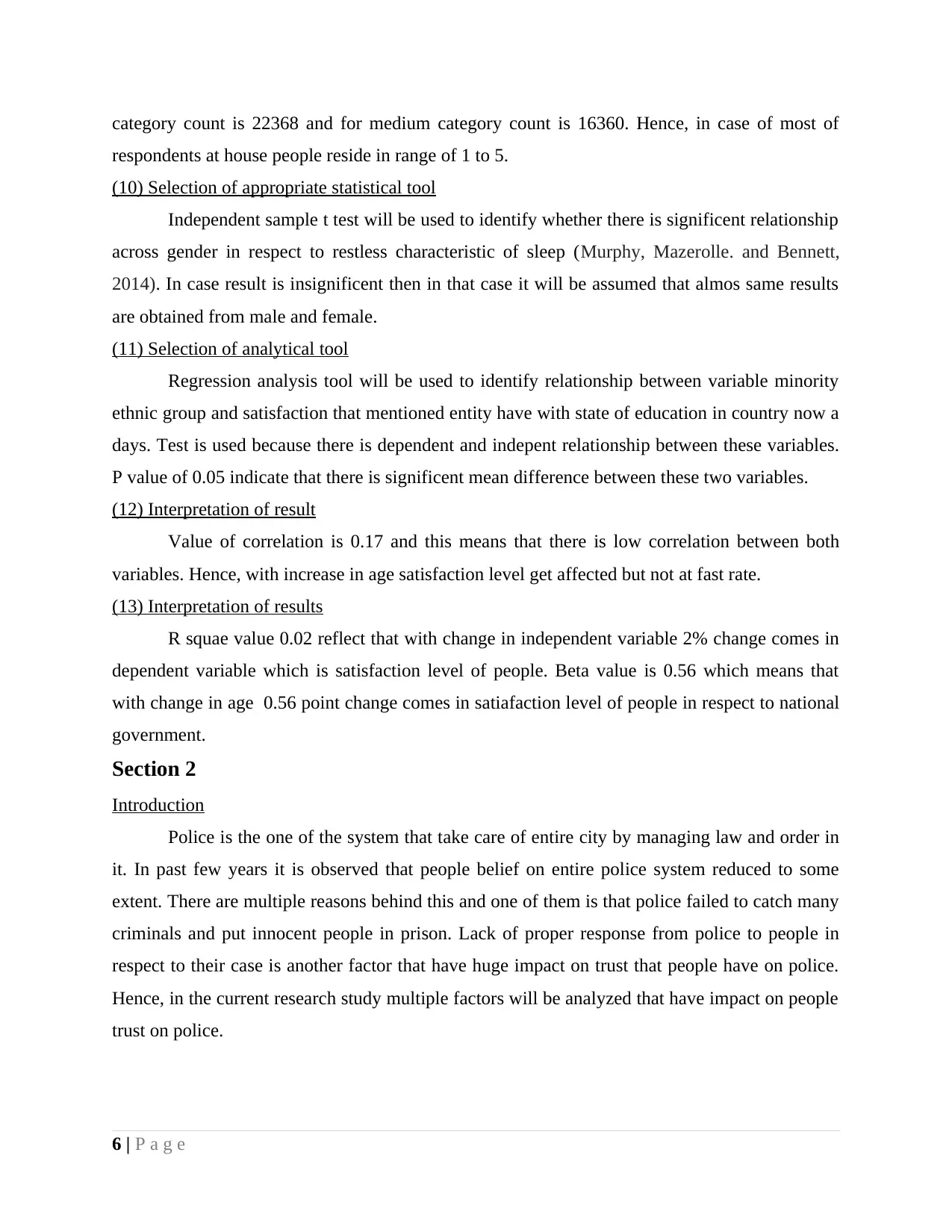
category count is 22368 and for medium category count is 16360. Hence, in case of most of
respondents at house people reside in range of 1 to 5.
(10) Selection of appropriate statistical tool
Independent sample t test will be used to identify whether there is significent relationship
across gender in respect to restless characteristic of sleep (Murphy, Mazerolle. and Bennett,
2014). In case result is insignificent then in that case it will be assumed that almos same results
are obtained from male and female.
(11) Selection of analytical tool
Regression analysis tool will be used to identify relationship between variable minority
ethnic group and satisfaction that mentioned entity have with state of education in country now a
days. Test is used because there is dependent and indepent relationship between these variables.
P value of 0.05 indicate that there is significent mean difference between these two variables.
(12) Interpretation of result
Value of correlation is 0.17 and this means that there is low correlation between both
variables. Hence, with increase in age satisfaction level get affected but not at fast rate.
(13) Interpretation of results
R squae value 0.02 reflect that with change in independent variable 2% change comes in
dependent variable which is satisfaction level of people. Beta value is 0.56 which means that
with change in age 0.56 point change comes in satiafaction level of people in respect to national
government.
Section 2
Introduction
Police is the one of the system that take care of entire city by managing law and order in
it. In past few years it is observed that people belief on entire police system reduced to some
extent. There are multiple reasons behind this and one of them is that police failed to catch many
criminals and put innocent people in prison. Lack of proper response from police to people in
respect to their case is another factor that have huge impact on trust that people have on police.
Hence, in the current research study multiple factors will be analyzed that have impact on people
trust on police.
6 | P a g e
respondents at house people reside in range of 1 to 5.
(10) Selection of appropriate statistical tool
Independent sample t test will be used to identify whether there is significent relationship
across gender in respect to restless characteristic of sleep (Murphy, Mazerolle. and Bennett,
2014). In case result is insignificent then in that case it will be assumed that almos same results
are obtained from male and female.
(11) Selection of analytical tool
Regression analysis tool will be used to identify relationship between variable minority
ethnic group and satisfaction that mentioned entity have with state of education in country now a
days. Test is used because there is dependent and indepent relationship between these variables.
P value of 0.05 indicate that there is significent mean difference between these two variables.
(12) Interpretation of result
Value of correlation is 0.17 and this means that there is low correlation between both
variables. Hence, with increase in age satisfaction level get affected but not at fast rate.
(13) Interpretation of results
R squae value 0.02 reflect that with change in independent variable 2% change comes in
dependent variable which is satisfaction level of people. Beta value is 0.56 which means that
with change in age 0.56 point change comes in satiafaction level of people in respect to national
government.
Section 2
Introduction
Police is the one of the system that take care of entire city by managing law and order in
it. In past few years it is observed that people belief on entire police system reduced to some
extent. There are multiple reasons behind this and one of them is that police failed to catch many
criminals and put innocent people in prison. Lack of proper response from police to people in
respect to their case is another factor that have huge impact on trust that people have on police.
Hence, in the current research study multiple factors will be analyzed that have impact on people
trust on police.
6 | P a g e
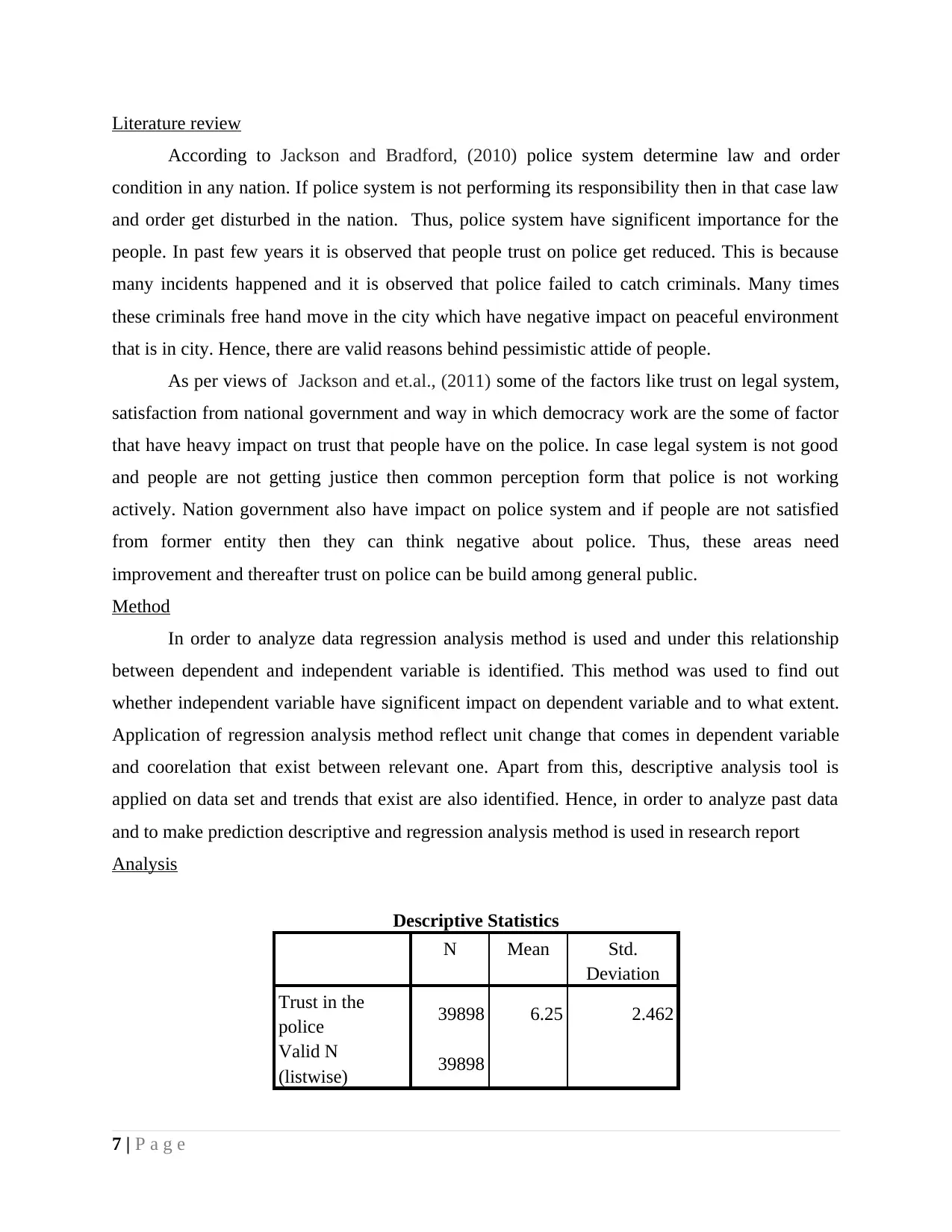
Literature review
According to Jackson and Bradford, (2010) police system determine law and order
condition in any nation. If police system is not performing its responsibility then in that case law
and order get disturbed in the nation. Thus, police system have significent importance for the
people. In past few years it is observed that people trust on police get reduced. This is because
many incidents happened and it is observed that police failed to catch criminals. Many times
these criminals free hand move in the city which have negative impact on peaceful environment
that is in city. Hence, there are valid reasons behind pessimistic attide of people.
As per views of Jackson and et.al., (2011) some of the factors like trust on legal system,
satisfaction from national government and way in which democracy work are the some of factor
that have heavy impact on trust that people have on the police. In case legal system is not good
and people are not getting justice then common perception form that police is not working
actively. Nation government also have impact on police system and if people are not satisfied
from former entity then they can think negative about police. Thus, these areas need
improvement and thereafter trust on police can be build among general public.
Method
In order to analyze data regression analysis method is used and under this relationship
between dependent and independent variable is identified. This method was used to find out
whether independent variable have significent impact on dependent variable and to what extent.
Application of regression analysis method reflect unit change that comes in dependent variable
and coorelation that exist between relevant one. Apart from this, descriptive analysis tool is
applied on data set and trends that exist are also identified. Hence, in order to analyze past data
and to make prediction descriptive and regression analysis method is used in research report
Analysis
Descriptive Statistics
N Mean Std.
Deviation
Trust in the
police 39898 6.25 2.462
Valid N
(listwise) 39898
7 | P a g e
According to Jackson and Bradford, (2010) police system determine law and order
condition in any nation. If police system is not performing its responsibility then in that case law
and order get disturbed in the nation. Thus, police system have significent importance for the
people. In past few years it is observed that people trust on police get reduced. This is because
many incidents happened and it is observed that police failed to catch criminals. Many times
these criminals free hand move in the city which have negative impact on peaceful environment
that is in city. Hence, there are valid reasons behind pessimistic attide of people.
As per views of Jackson and et.al., (2011) some of the factors like trust on legal system,
satisfaction from national government and way in which democracy work are the some of factor
that have heavy impact on trust that people have on the police. In case legal system is not good
and people are not getting justice then common perception form that police is not working
actively. Nation government also have impact on police system and if people are not satisfied
from former entity then they can think negative about police. Thus, these areas need
improvement and thereafter trust on police can be build among general public.
Method
In order to analyze data regression analysis method is used and under this relationship
between dependent and independent variable is identified. This method was used to find out
whether independent variable have significent impact on dependent variable and to what extent.
Application of regression analysis method reflect unit change that comes in dependent variable
and coorelation that exist between relevant one. Apart from this, descriptive analysis tool is
applied on data set and trends that exist are also identified. Hence, in order to analyze past data
and to make prediction descriptive and regression analysis method is used in research report
Analysis
Descriptive Statistics
N Mean Std.
Deviation
Trust in the
police 39898 6.25 2.462
Valid N
(listwise) 39898
7 | P a g e
⊘ This is a preview!⊘
Do you want full access?
Subscribe today to unlock all pages.

Trusted by 1+ million students worldwide
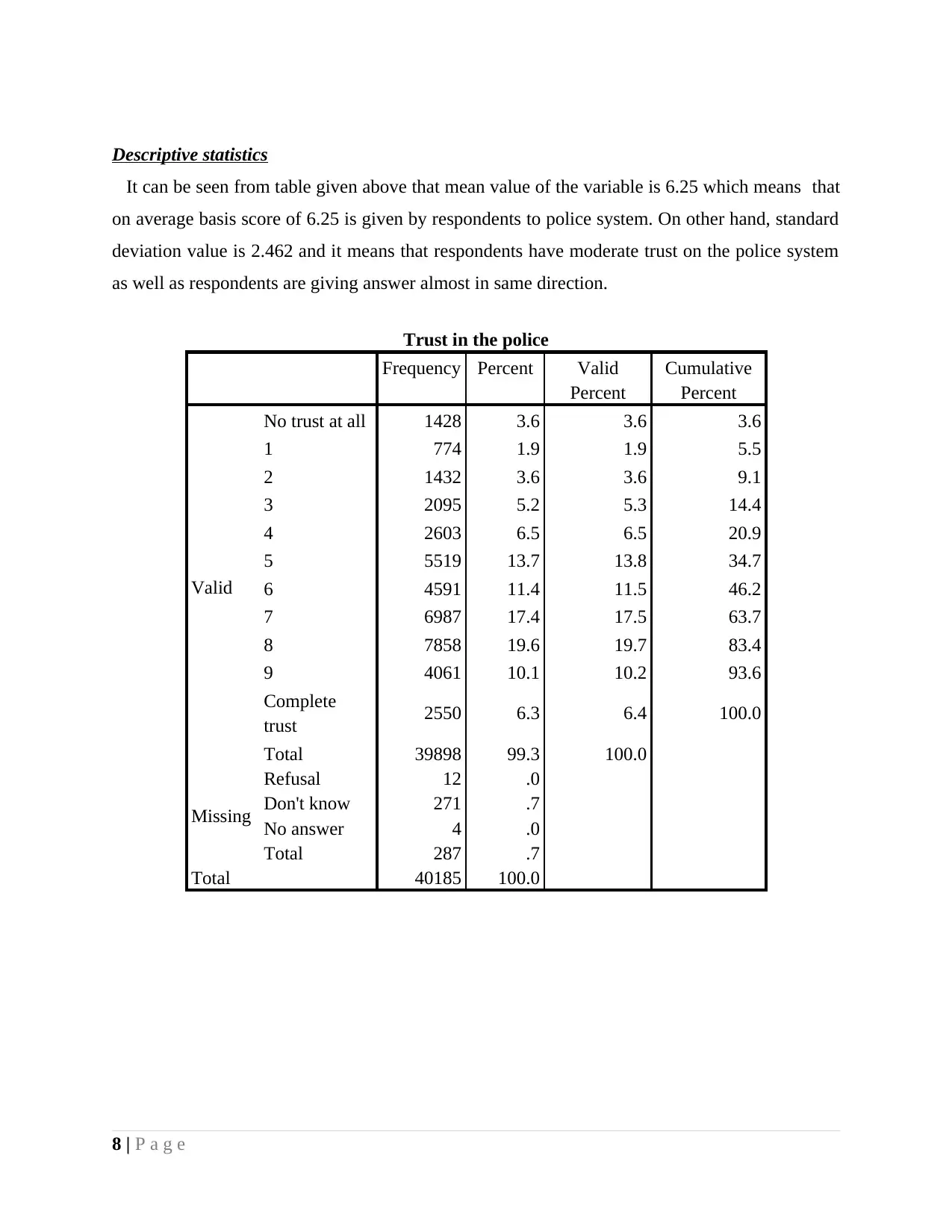
Descriptive statistics
It can be seen from table given above that mean value of the variable is 6.25 which means that
on average basis score of 6.25 is given by respondents to police system. On other hand, standard
deviation value is 2.462 and it means that respondents have moderate trust on the police system
as well as respondents are giving answer almost in same direction.
Trust in the police
Frequency Percent Valid
Percent
Cumulative
Percent
Valid
No trust at all 1428 3.6 3.6 3.6
1 774 1.9 1.9 5.5
2 1432 3.6 3.6 9.1
3 2095 5.2 5.3 14.4
4 2603 6.5 6.5 20.9
5 5519 13.7 13.8 34.7
6 4591 11.4 11.5 46.2
7 6987 17.4 17.5 63.7
8 7858 19.6 19.7 83.4
9 4061 10.1 10.2 93.6
Complete
trust 2550 6.3 6.4 100.0
Total 39898 99.3 100.0
Missing
Refusal 12 .0
Don't know 271 .7
No answer 4 .0
Total 287 .7
Total 40185 100.0
8 | P a g e
It can be seen from table given above that mean value of the variable is 6.25 which means that
on average basis score of 6.25 is given by respondents to police system. On other hand, standard
deviation value is 2.462 and it means that respondents have moderate trust on the police system
as well as respondents are giving answer almost in same direction.
Trust in the police
Frequency Percent Valid
Percent
Cumulative
Percent
Valid
No trust at all 1428 3.6 3.6 3.6
1 774 1.9 1.9 5.5
2 1432 3.6 3.6 9.1
3 2095 5.2 5.3 14.4
4 2603 6.5 6.5 20.9
5 5519 13.7 13.8 34.7
6 4591 11.4 11.5 46.2
7 6987 17.4 17.5 63.7
8 7858 19.6 19.7 83.4
9 4061 10.1 10.2 93.6
Complete
trust 2550 6.3 6.4 100.0
Total 39898 99.3 100.0
Missing
Refusal 12 .0
Don't know 271 .7
No answer 4 .0
Total 287 .7
Total 40185 100.0
8 | P a g e
Paraphrase This Document
Need a fresh take? Get an instant paraphrase of this document with our AI Paraphraser
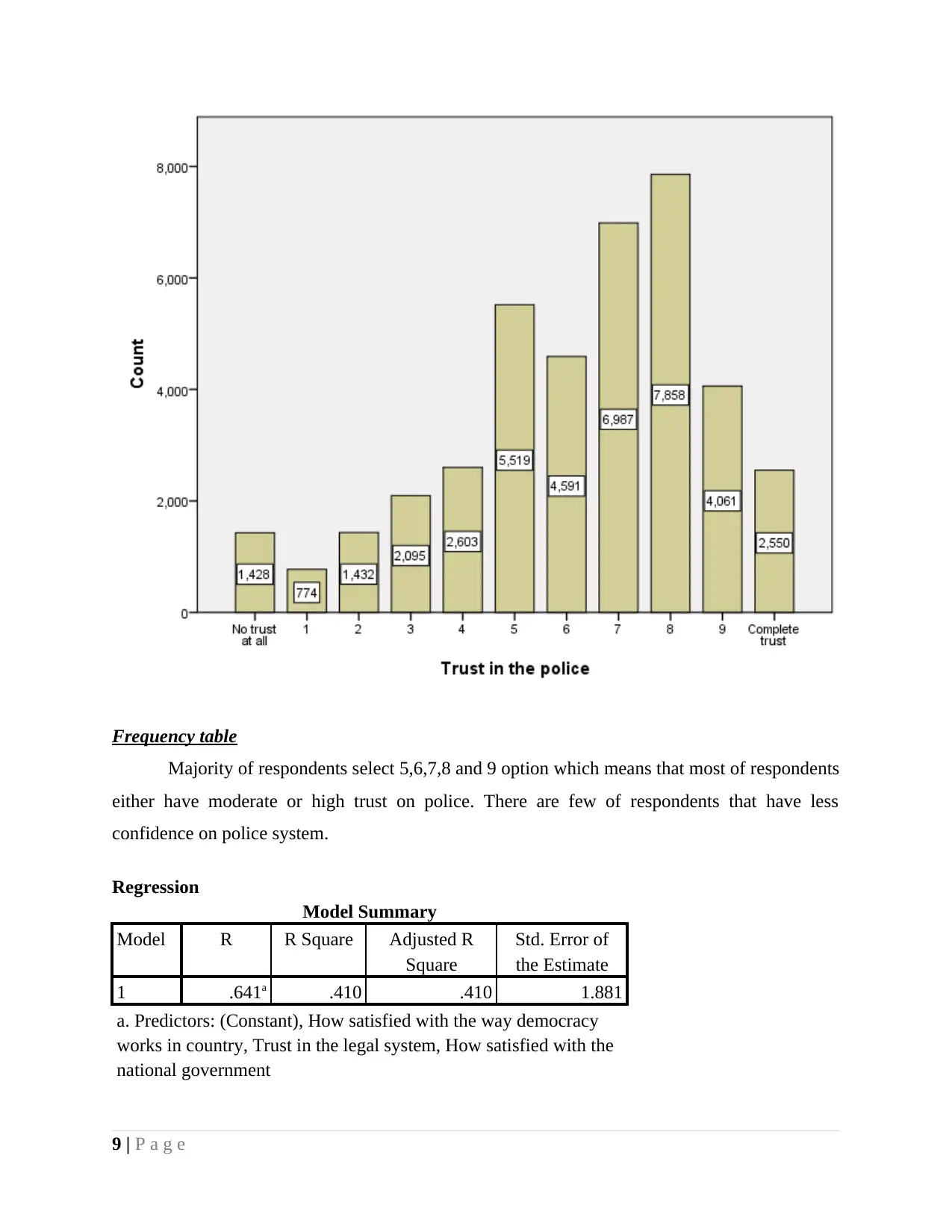
Frequency table
Majority of respondents select 5,6,7,8 and 9 option which means that most of respondents
either have moderate or high trust on police. There are few of respondents that have less
confidence on police system.
Regression
Model Summary
Model R R Square Adjusted R
Square
Std. Error of
the Estimate
1 .641a .410 .410 1.881
a. Predictors: (Constant), How satisfied with the way democracy
works in country, Trust in the legal system, How satisfied with the
national government
9 | P a g e
Majority of respondents select 5,6,7,8 and 9 option which means that most of respondents
either have moderate or high trust on police. There are few of respondents that have less
confidence on police system.
Regression
Model Summary
Model R R Square Adjusted R
Square
Std. Error of
the Estimate
1 .641a .410 .410 1.881
a. Predictors: (Constant), How satisfied with the way democracy
works in country, Trust in the legal system, How satisfied with the
national government
9 | P a g e
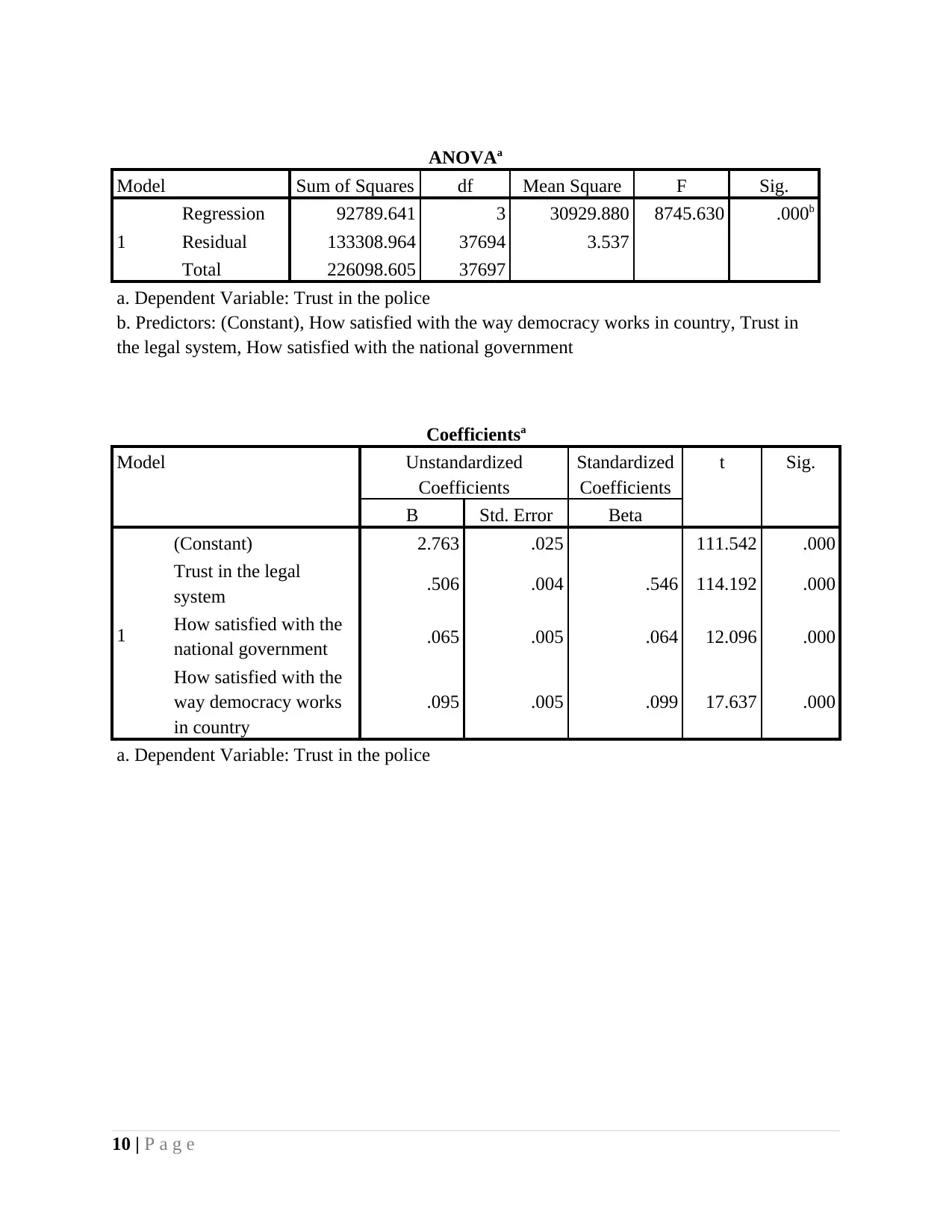
ANOVAa
Model Sum of Squares df Mean Square F Sig.
1
Regression 92789.641 3 30929.880 8745.630 .000b
Residual 133308.964 37694 3.537
Total 226098.605 37697
a. Dependent Variable: Trust in the police
b. Predictors: (Constant), How satisfied with the way democracy works in country, Trust in
the legal system, How satisfied with the national government
Coefficientsa
Model Unstandardized
Coefficients
Standardized
Coefficients
t Sig.
B Std. Error Beta
1
(Constant) 2.763 .025 111.542 .000
Trust in the legal
system .506 .004 .546 114.192 .000
How satisfied with the
national government .065 .005 .064 12.096 .000
How satisfied with the
way democracy works
in country
.095 .005 .099 17.637 .000
a. Dependent Variable: Trust in the police
10 | P a g e
Model Sum of Squares df Mean Square F Sig.
1
Regression 92789.641 3 30929.880 8745.630 .000b
Residual 133308.964 37694 3.537
Total 226098.605 37697
a. Dependent Variable: Trust in the police
b. Predictors: (Constant), How satisfied with the way democracy works in country, Trust in
the legal system, How satisfied with the national government
Coefficientsa
Model Unstandardized
Coefficients
Standardized
Coefficients
t Sig.
B Std. Error Beta
1
(Constant) 2.763 .025 111.542 .000
Trust in the legal
system .506 .004 .546 114.192 .000
How satisfied with the
national government .065 .005 .064 12.096 .000
How satisfied with the
way democracy works
in country
.095 .005 .099 17.637 .000
a. Dependent Variable: Trust in the police
10 | P a g e
⊘ This is a preview!⊘
Do you want full access?
Subscribe today to unlock all pages.

Trusted by 1+ million students worldwide
1 out of 15